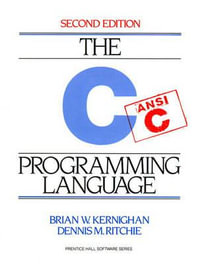
Introduction to Predictive Maintenance
By: R. Keith Mobley
Hardcover | 26 September 2002 | Edition Number 2
At a Glance
456 Pages
Revised
23.5 x 15.88 x 2.54
Hardcover
RRP $183.95
$168.75
or 4 interest-free payments of $42.19 with
orShips in 5 to 7 business days
This second edition of An Introduction to Predictive Maintenance helps plant, process, maintenance and reliability managers and engineers to develop and implement a comprehensive maintenance management program, providing proven strategies for regularly monitoring critical process equipment and systems, predicting machine failures, and scheduling maintenance accordingly.
Since the publication of the first edition in 1990, there have been many changes in both technology and methodology, including financial implications, the role of a maintenance organization, predictive maintenance techniques, various analyses, and maintenance of the program itself. This revision includes a complete update of the applicable chapters from the first edition as well as six additional chapters outlining the most recent information available.
Having already been implemented and maintained successfully in hundreds of manufacturing and process plants worldwide, the practices detailed in this second edition of An Introduction to Predictive Maintenance will save plants and corporations, as well as U.S. industry as a whole, billions of dollars by minimizing unexpected equipment failures and its resultant high maintenance cost while increasing productivity.
- A comprehensive introduction to a system of monitoring critical industrial equipment
- Optimize the availability of process machinery and greatly reduce the cost of maintenance
- Provides the means to improve product quality, productivity and profitability of manufacturing and production plants
Industry Reviews
| Impact of Maintenance | p. 1 |
| Maintenance Management Methods | p. 2 |
| Run-to-Failure Management | p. 2 |
| Preventive Maintenance | p. 3 |
| Predictive Maintenance | p. 4 |
| Other Maintenance Improvement Methods | p. 6 |
| Optimizing Predictive Maintenance | p. 10 |
| Culture Change | p. 10 |
| Proper Use of Predictive Technologies | p. 12 |
| It Takes More Than Effective Maintenance | p. 17 |
| Small Plants | p. 20 |
| Large Plants | p. 21 |
| Financial Implications and Cost Justification | p. 23 |
| Assessing the Need for Condition Monitoring | p. 24 |
| Cost Justification | p. 25 |
| Poor-Quality Product as Plant Performance Deteriorates | p. 27 |
| Increased Cost of Fuel and Other Consumables as the Plant Condition Deteriorates | p. 27 |
| Cost of Current Maintenance Strategy | p. 27 |
| Justifying Predictive Maintenance | p. 29 |
| Installation Cost | p. 29 |
| Operating Cost | p. 31 |
| Conclusions | p. 31 |
| Economics of Preventive Maintenance | p. 32 |
| Benefits versus Costs | p. 33 |
| Role of Maintenance Organization | p. 43 |
| Maintenance Mission | p. 43 |
| Optimum Availability | p. 43 |
| Optimum Operating Condition | p. 44 |
| Maximum Utilization of Maintenance Resources | p. 44 |
| Optimum Equipment Life | p. 44 |
| Minimum Spares Inventory | p. 44 |
| Ability to React Quickly | p. 44 |
| Evaluation of the Maintenance Organization | p. 44 |
| Three Types of Maintenance | p. 45 |
| Designing a Predictive Maintenance Program | p. 50 |
| Failure Data | p. 51 |
| Improving Equipment Reliability | p. 52 |
| Improvement Process | p. 54 |
| Failures That Can Be Prevented | p. 55 |
| Maintenance to Prevent Failures | p. 55 |
| Personnel | p. 56 |
| Service Teams | p. 56 |
| How to Start | p. 58 |
| Benefits of Predictive Maintenance | p. 60 |
| Primary Uses of Predictive Maintenance | p. 61 |
| As a Maintenance Management Tool | p. 61 |
| As a Plant Optimization Tool | p. 69 |
| As a Reliability Improvement Tool | p. 69 |
| The Difference | p. 70 |
| Benefits of a Total-Plant Predictive Program | p. 70 |
| Machine-Train Monitoring Parameters | p. 74 |
| Drivers | p. 75 |
| Electric Motors | p. 75 |
| Steam Turbines | p. 77 |
| Intermediate Drives | p. 78 |
| Chains | p. 78 |
| Couplings | p. 79 |
| Gearboxes | p. 81 |
| V-Belts | p. 83 |
| Driven Components | p. 86 |
| Compressors | p. 86 |
| Fans | p. 92 |
| Generators | p. 93 |
| Process Rolls | p. 94 |
| Pumps | p. 95 |
| Predictive Maintenance Techniques | p. 99 |
| Vibration Monitoring | p. 99 |
| Technology Limitations | p. 100 |
| Thermography | p. 105 |
| Types of Thermographic Systems | p. 106 |
| Infrared Thermography Safety | p. 107 |
| Tribology | p. 108 |
| Lube Oil Analysis | p. 108 |
| Wear Particle Analysis | p. 109 |
| Limitations of Tribology | p. 109 |
| Visual Inspections | p. 111 |
| Ultrasonics | p. 111 |
| Other Techniques | p. 112 |
| Electrical Testing | p. 112 |
| Vibration Monitoring and Analysis | p. 114 |
| Vibration Analysis Applications | p. 114 |
| Predictive Maintenance | p. 115 |
| Acceptance Testing | p. 115 |
| Quality Control | p. 116 |
| Loose or Foreign Parts Detection | p. 116 |
| Noise Control | p. 116 |
| Leak Detections | p. 116 |
| Aircraft Engine Analyzers | p. 116 |
| Machine Design and Engineering | p. 116 |
| Vibration Analysis Overview | p. 117 |
| Theoretical Vibration Profiles | p. 117 |
| Actual Vibration Profiles | p. 118 |
| Interpretation of Vibration Data | p. 120 |
| Vibration-Measuring Equipment | p. 121 |
| Vibration Sources | p. 122 |
| Rotating Machinery | p. 122 |
| Reciprocating and/or Linear-Motion Machinery | p. 124 |
| Vibration Theory | p. 125 |
| Periodic Motion | p. 125 |
| Measurable Parameters | p. 129 |
| Machine Dynamics | p. 132 |
| Mass, Stiffness, and Damping | p. 133 |
| Degrees of Freedom | p. 142 |
| Vibration Data Types and Formats | p. 146 |
| Data Types | p. 146 |
| Data Formats | p. 150 |
| Data Acquisition | p. 152 |
| Vibration Detectors: Transducers and Cables | p. 152 |
| Data Measurements | p. 156 |
| Transducer Mounting Techniques | p. 157 |
| Acquiring Data | p. 160 |
| Vibration Analyses Techniques | p. 161 |
| Trending | p. 161 |
| Comparative Analysis | p. 162 |
| Signature Analysis | p. 164 |
| Abbreviations | p. 165 |
| Glossary | p. 166 |
| References | p. 171 |
| Thermography | p. 172 |
| Infrared Basics | p. 172 |
| Types of Infrared Instruments | p. 174 |
| Infrared Thermometers | p. 174 |
| Line Scanners | p. 175 |
| Infrared Imaging | p. 175 |
| Training | p. 175 |
| Basic Infrared Theory | p. 176 |
| Electromagnetic Spectrum | p. 176 |
| Heat Transfer Concepts | p. 177 |
| Infrared Equipment | p. 178 |
| Infrared Thermography Safety | p. 179 |
| Infrared Scanning Procedures | p. 179 |
| Types of Infrared Problems | p. 179 |
| Mechanical Looseness | p. 180 |
| Component Failure | p. 180 |
| Common Problems Found and What to Scan | p. 180 |
| Abbreviations | p. 183 |
| Glossary | p. 183 |
| Electrical Terminology | p. 187 |
| Materials List | p. 193 |
| Tribology | p. 202 |
| Lubricating Oil Analysis | p. 203 |
| Oil Analysis Tests | p. 203 |
| Wear Particle Analysis | p. 205 |
| Ferrography | p. 207 |
| Oil Analysis Costs and Uses | p. 207 |
| Setting Up an Effective Program | p. 208 |
| Equipment Audit | p. 209 |
| Lubricant Audit Process | p. 211 |
| Baseline Signature | p. 212 |
| Monitoring | p. 213 |
| Program Evaluation | p. 215 |
| Process Parameters | p. 217 |
| Pumps | p. 218 |
| Centrifugal Pumps | p. 218 |
| Positive-Displacement Pumps | p. 222 |
| Fans, Blowers, and Fluidizers | p. 225 |
| Centrifugal Fans | p. 225 |
| Blowers or Positive-Displacement Fans | p. 228 |
| Conveyors | p. 229 |
| Pneumatic | p. 229 |
| Chain-Type Mechanical | p. 229 |
| Compressors | p. 229 |
| Centrifugal | p. 229 |
| Rotary-Type Positive Displacement | p. 231 |
| Reciprocating Positive Displacement | p. 235 |
| Mixers and Agitators | p. 240 |
| Dust Collectors | p. 240 |
| Baghouses | p. 240 |
| Cyclonic Separators | p. 240 |
| Process Rolls | p. 241 |
| Gearboxes/Reducers | p. 242 |
| Normal Wear | p. 246 |
| Abnormal Wear | p. 246 |
| Steam Traps | p. 249 |
| Inverters | p. 249 |
| Control Valves | p. 249 |
| Seals and Packing | p. 251 |
| Mechanical Seals | p. 251 |
| Packed Boxes | p. 254 |
| Ultrasonics | p. 256 |
| Ultrasonic Applications | p. 256 |
| Airborne Noise Analysis | p. 256 |
| Leak Detection | p. 257 |
| Materials Testing | p. 257 |
| Types of Ultrasonic Systems | p. 257 |
| Limitations | p. 258 |
| Visual Inspection | p. 259 |
| Visual Inspection Methods | p. 260 |
| Human Senses | p. 261 |
| Sensors | p. 261 |
| Spectrometric Oil Analysis | p. 263 |
| Thresholds | p. 263 |
| Operating Dynamics Analysis | p. 267 |
| It's Not Predictive Maintenance | p. 267 |
| Technology Limitations | p. 268 |
| Limitation to Maintenance Issues | p. 268 |
| Influence of Process Variables | p. 269 |
| Training Limitations | p. 270 |
| Understanding Machine Dynamics | p. 271 |
| Interpreting Operating Dynamics | p. 281 |
| Failure-Mode Analysis | p. 285 |
| Common General Failure Modes | p. 286 |
| Critical Speeds | p. 286 |
| Imbalance | p. 288 |
| Mechanical Looseness | p. 290 |
| Misalignment | p. 293 |
| Modulations | p. 294 |
| Process Instability | p. 296 |
| Resonance | p. 297 |
| Failure Modes by Machine-Train Component | p. 301 |
| Bearings: Rolling Element | p. 302 |
| Bearings: Sleeve (Babbitt) | p. 303 |
| Chains and Sprockets | p. 304 |
| Gears | p. 306 |
| Jackshafts and Spindles | p. 309 |
| Process Rolls | p. 312 |
| Shaft | p. 318 |
| V-Belts | p. 318 |
| Establishing a Predictive Maintenance Program | p. 325 |
| Goals, Objectives, and Benefits | p. 325 |
| Functional Requirements | p. 326 |
| Management Support | p. 327 |
| Dedicated and Accountable Personnel | p. 327 |
| Efficient Data Collection and Analysis Procedures | p. 327 |
| Viable Database | p. 328 |
| Selling Predictive Maintenance Programs | p. 330 |
| Six Keys to Success | p. 330 |
| Selecting a Predictive Maintenance System | p. 334 |
| Fundamental System Requirements | p. 335 |
| Database Development | p. 343 |
| Establishing Data Acquisition Frequency | p. 343 |
| Setting Up Analysis Parameters | p. 344 |
| Setting Boundaries for Signature Analysis | p. 344 |
| Defining Alert and Alarm Limits | p. 345 |
| Selecting Transducers | p. 346 |
| Getting Started | p. 348 |
| Training | p. 349 |
| Technical Support | p. 350 |
| A Total-Plant Predictive Maintenance Program | p. 352 |
| The Optimum Predictive Maintenance Program | p. 353 |
| Predictive Technologies | p. 353 |
| The Optimum Predictive Maintenance System | p. 355 |
| Predictive Is Not Enough | p. 356 |
| Effective Planning and Scheduling | p. 356 |
| Preventive Maintenance Tasks | p. 357 |
| Motivation | p. 373 |
| Record Keeping | p. 380 |
| Special Concerns | p. 383 |
| Conclusion | p. 387 |
| Maintaining the Program | p. 389 |
| Trending Techniques | p. 389 |
| Analysis Techniques | p. 390 |
| Broadband Analysis | p. 390 |
| Narrowband Analysis | p. 391 |
| Root-Cause Failure Analysis | p. 392 |
| Additional Training | p. 392 |
| Technical Support | p. 393 |
| Contract Predictive Maintenance Programs | p. 393 |
| World-Class Maintenance | p. 394 |
| What Is World-Class Maintenance? | p. 394 |
| Five Fundamentals of World-Class Performance | p. 395 |
| Improving Equipment Effectiveness | p. 395 |
| Involving Operators in Daily Maintenance | p. 395 |
| Improving Maintenance Efficiency and Effectiveness | p. 396 |
| Educating and Training | p. 396 |
| Designing and Managing Equipment for Maintenance Prevention | p. 396 |
| Competitive Advantage | p. 396 |
| Focus on Quality | p. 397 |
| Focus on Maintenance | p. 398 |
| Overall Equipment Effectiveness | p. 402 |
| Elements of Effective Maintenance | p. 406 |
| Commitment | p. 406 |
| Cost | p. 408 |
| Culture | p. 408 |
| Customer Focus | p. 409 |
| Management Commitment | p. 410 |
| Change | p. 410 |
| Management Philosophy | p. 410 |
| Risk Taking | p. 410 |
| Information | p. 410 |
| Roles | p. 410 |
| Teamwork | p. 410 |
| Strategy | p. 410 |
| Tasks | p. 411 |
| Decision Making | p. 411 |
| Stability | p. 411 |
| Innovation | p. 411 |
| Trust | p. 411 |
| Problem Solving | p. 411 |
| Responsibilities | p. 412 |
| Optimum Availability | p. 412 |
| Optimum Operating Condition | p. 412 |
| Maximum Utilization of Maintenance Resources | p. 412 |
| Optimum Equipment Life | p. 413 |
| Minimum Spares Inventory | p. 413 |
| Ability to React Quickly | p. 413 |
| Three Types of Maintenance | p. 413 |
| Corrective Maintenance | p. 413 |
| Preventive Maintenance | p. 414 |
| Maintenance Improvement | p. 415 |
| Advantages and Disadvantages | p. 416 |
| Supervision | p. 419 |
| Functions of Supervision | p. 419 |
| Characteristics of Effective Supervision | p. 421 |
| Working without Supervision | p. 422 |
| Standard Procedures | p. 424 |
| Reasons for Not Using Standard Procedures | p. 424 |
| Creating Standard Procedures | p. 425 |
| Standard Procedures Are Not Enough | p. 426 |
| Workforce Development | p. 426 |
| Lack of Basic Skills | p. 426 |
| Workforce Maturity | p. 426 |
| Unskilled Workforce Pool | p. 427 |
| Manufacturing Extension Partnership | p. 427 |
| U.S. Department of Labor Employment and Training Administration | p. 428 |
| Apprenticeship Programs | p. 428 |
| Training Grants | p. 429 |
| America's Job Bank | p. 432 |
| Table of Contents provided by Syndetics. All Rights Reserved. |
ISBN: 9780750675314
ISBN-10: 0750675314
Series: Plant Engineering
Published: 26th September 2002
Format: Hardcover
Language: English
Number of Pages: 456
Audience: Professional and Scholarly
Publisher: Butterworth-Heinemann
Country of Publication: GB
Edition Number: 2
Edition Type: Revised
Dimensions (cm): 23.5 x 15.88 x 2.54
Weight (kg): 0.79
Shipping
| Standard Shipping | Express Shipping | |
|---|---|---|
| Metro postcodes: | $9.99 | $14.95 |
| Regional postcodes: | $9.99 | $14.95 |
| Rural postcodes: | $9.99 | $14.95 |
Orders over $79.00 qualify for free shipping.
How to return your order
At Booktopia, we offer hassle-free returns in accordance with our returns policy. If you wish to return an item, please get in touch with Booktopia Customer Care.
Additional postage charges may be applicable.
Defective items
If there is a problem with any of the items received for your order then the Booktopia Customer Care team is ready to assist you.
For more info please visit our Help Centre.
You Can Find This Book In

Astronomy for Curious Kids
An illustrated introduction to the solar system, our galaxy, space travel-and more!
Hardcover
RRP $32.99
$28.75
OFF

Biofuel Perspectives
Methanol and Ethanol in Combustion Engines from Production to Practical Application
Paperback
RRP $363.95
$322.75
OFF
This product is categorised by
- Non-FictionIndustry & Industrial StudiesIndustrial Relations, Health & SafetyHealth & Safety Issues
- Non-FictionEngineering & TechnologyTechnology in GeneralEngineering in General
- Non-FictionEngineering & TechnologyTechnology in GeneralInstruments & Instrumentation Engineering
- Non-FictionEngineering & TechnologyIndustrial Chemistry & Manufacturing Technologies
- Non-FictionBusiness & ManagementManagement & Management TechniquesManagement of Specific AreasManagement of Real Estate
- Non-FictionEngineering & TechnologyTechnology in General






















